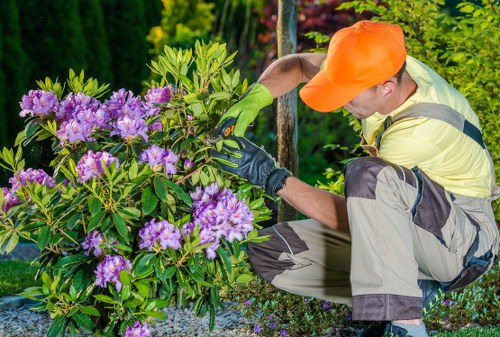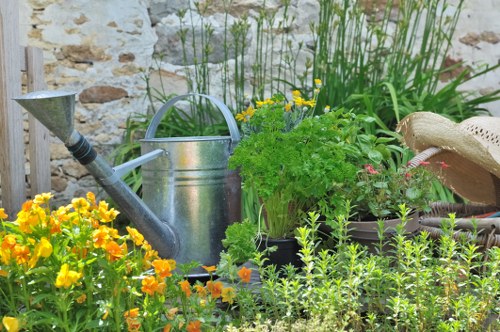Hedge Trimming in Ilford: Your Complete Guide to Beautiful Hedges
Introduction to Hedge Trimming in Ilford

Maintaining beautiful hedges is essential for the aesthetic appeal and overall health of your garden. In Ilford, where the climate can vary, regular hedge trimming ensures that your greenery remains lush and well-shaped. Whether you are a homeowner or a property manager, understanding the nuances of hedge trimming in Ilford can make a significant difference in the appearance and longevity of your hedges.
Hedge trimming is not just about keeping your garden tidy; it also plays a crucial role in the health of your plants. Proper trimming encourages growth, prevents disease, and maintains the desired shape and size of your hedges. In Ilford, where seasonal changes can impact plant health, regular maintenance is particularly important.
This guide will walk you through everything you need to know about hedge trimming in Ilford, from the best times to trim to the tools you'll need and whether to hire a professional or take the DIY route.
The Importance of Hedge Trimming

Regular hedge trimming is vital for several reasons. First and foremost, it helps maintain the desired shape and size of your hedges, ensuring they complement your garden's overall design. Overgrown hedges can become unruly and detract from the beauty of your outdoor space.
Additionally, trimming promotes healthy growth. By removing dead or diseased branches, you prevent the spread of pests and diseases, safeguarding the rest of your hedge. It also allows more light and air to reach the inner parts of the plant, which enhances photosynthesis and overall plant vigor.
In Ilford, with its diverse range of plant species, understanding the specific needs of your hedges is essential. Different plants may require varying trimming techniques and schedules to thrive in the local climate.
When to Trim Your Hedges

Timing is crucial when it comes to hedge trimming in Ilford. The best time to trim most hedges is during the late winter or early spring, just before the new growth begins. This timing allows the plants to recover quickly and promotes vigorous growth in the spring and summer months.
However, some hedges may benefit from additional trimming in the summer to maintain their shape and encourage dense growth. It's important to research the specific type of hedge you have to determine the optimal trimming schedule.
Additionally, avoiding extreme weather conditions is key. Trimming during periods of frost or heavy rain can damage the plants and hinder their recovery. Always aim for a mild, dry day when planning your hedge trimming activities.
Techniques and Tools for Effective Hedge Trimming

Using the right techniques and tools is essential for successful hedge trimming. Here are some key tools you'll need:
- Pruning Shears: Ideal for small branches and precise cuts.
- Hedge Trimmers: Perfect for larger areas and achieving a uniform shape.
- Loppers: Useful for thicker branches that shear clippers can't handle.
- Protective Gear: Gloves, safety glasses, and sturdy footwear to ensure safety while trimming.
When trimming, always strive for a natural shape that complements the overall design of your garden. Avoid cutting too much at once, as this can stress the plant. Instead, make gradual adjustments to achieve the desired form.
Maintaining sharp tools is also important. Dull blades can damage the plants and lead to uneven cuts, increasing the risk of disease.
Hiring a Professional vs. DIY Hedge Trimming

Deciding whether to hire a professional hedge trimming service in Ilford or do it yourself depends on several factors. Professionals bring expertise, ensuring that the job is done efficiently and correctly. They have the right tools and knowledge of local plant species, which can be invaluable for maintaining the health and appearance of your hedges.
On the other hand, DIY trimming can be more cost-effective and offers a sense of satisfaction from maintaining your own garden. If you have the time, the necessary tools, and some basic knowledge of horticulture, trimming your own hedges can be a rewarding task.
Consider the size of your hedges, the complexity of the job, and your own skill level when making this decision. For larger properties or more intricate trimming needs, hiring a professional might be the best choice.
Cost of Hedge Trimming in Ilford
The cost of hedge trimming in Ilford can vary based on several factors, including the size of your hedges, the complexity of the trimming required, and whether you choose a professional service or a DIY approach.
Professional hedge trimming services typically charge based on the length and height of the hedges, as well as the time required to complete the job. On average, homeowners in Ilford can expect to pay between £50 and £150 for standard hedge trimming services.
For those opting to trim their hedges themselves, the primary costs will be for tools and equipment. Investing in high-quality hedge trimmers and pruning shears can save money in the long run, as they are more durable and efficient.
Maintaining Your Hedges After Trimming
Proper maintenance after trimming is essential to ensure the continued health and beauty of your hedges. Here are some tips:
- Watering: Ensure your hedges receive adequate water, especially during dry spells.
- Fertilizing: Apply a balanced fertilizer in the spring to promote healthy growth.
- Pest Control: Regularly inspect your hedges for signs of pests or disease and take appropriate action.
- Mulching: Apply mulch around the base to retain moisture and suppress weeds.
By following these maintenance practices, you can keep your hedges in pristine condition year-round.
Choosing the Right Hedge for Your Ilford Garden
Selecting the appropriate hedge type is the first step in ensuring successful trimming and maintenance. In Ilford, several popular hedge varieties thrive well:
- Boxwood: Known for its dense foliage and ability to be shaped into formal designs.
- Privet: A fast-growing option that can provide quick privacy and is easy to trim.
- Yew: Evergreen with a rich green color, ideal for high hedges and formal gardens.
- Holly: Offers both beauty and protection with its spiky leaves and bright berries.
Consider factors like growth rate, maintenance requirements, and desired appearance when selecting a hedge type for your garden.
Common Mistakes to Avoid When Trimming Hedges
Avoiding common hedge trimming mistakes can save your plants from unnecessary stress and damage. Here are some pitfalls to watch out for:
- Over-Trimming: Cutting too much can shock the plant, leading to poor growth and increased susceptibility to disease.
- Using Dull Tools: Dull blades can make uneven cuts, causing damage to the plant tissues.
- Ignoring Plant Type: Different hedges have varying trimming needs; not tailoring your approach can harm the plant.
- Trimming at the Wrong Time: Seasonal timing is crucial; trimming during unfavorable weather can hinder recovery.
Being mindful of these mistakes will help you maintain healthy and attractive hedges.
Seasonal Hedge Trimming Tips for Ilford
Understanding seasonal variations is key to effective hedge trimming in Ilford. Each season has its own set of best practices:
- Spring: Perform major trims to encourage new growth. Remove any dead or damaged branches.
- Summer: Light trimming can help maintain shape and promote dense foliage.
- Autumn: Prepare hedges for winter by cutting back any overgrown areas and removing fallen leaves.
- Winter: Generally, avoid trimming unless absolutely necessary. If trimming is required, do so on a dry day to prevent disease.
Adapting your trimming routine to the seasons will ensure your hedges remain healthy and vibrant throughout the year.
Eco-Friendly Hedge Trimming Practices
Adopting eco-friendly hedge trimming practices contributes to a sustainable garden in Ilford. Here are some ways to trim your hedges responsibly:
- Use Electric Tools: Opt for electric hedge trimmers over gas-powered ones to reduce carbon emissions.
- Recycle Clippings: Compost the trimmed branches and leaves instead of sending them to landfill.
- Choose Sustainable Materials: Select hedge species that are native or well-suited to the local environment, requiring less water and maintenance.
- Minimize Waste: Trim only what is necessary to maintain the health and shape of your hedges, avoiding excessive cutting.
Implementing these practices not only benefits the environment but also enhances the overall sustainability of your garden.
DIY vs. Professional Hedge Trimming: Making the Right Choice
When deciding between DIY hedge trimming and hiring a professional service in Ilford, consider the following:
- Expertise: Professionals have the experience and knowledge to handle various hedge types and complex trimming tasks.
- Time: Trimming hedges can be time-consuming, especially for larger gardens. Professionals can complete the job quickly and efficiently.
- Cost: While DIY can save money upfront, professional services offer quality and guarantees that may save costs in the long run.
- Equipment: Professionals come equipped with the necessary tools, reducing the need for personal investment in expensive equipment.
Assess your own skills, time availability, and budget to determine the best approach for your hedge trimming needs.
Choosing the Right Hedge Trimming Service in Ilford
Selecting a reliable hedge trimming service in Ilford involves several considerations:
- Reputation: Look for services with positive reviews and testimonials from satisfied customers.
- Experience: Choose a company with a proven track record in hedge trimming and garden maintenance.
- Insurance: Ensure the service provider is insured to cover any potential damage during the trimming process.
- Pricing: Compare quotes from different providers to find a balance between cost and quality.
- Services Offered: Some companies offer additional services like garden design, pest control, and seasonal maintenance, which can be beneficial.
Taking the time to research and select the right service will ensure your hedges are trimmed professionally and to your satisfaction.
Benefits of Regular Hedge Trimming
Engaging in regular hedge trimming in Ilford offers numerous benefits:
- Enhanced Curb Appeal: Well-maintained hedges significantly improve the visual appeal of your property.
- Increased Property Value: A beautifully landscaped garden with tidy hedges can boost the overall value of your home.
- Healthier Plants: Regular trimming promotes robust growth and reduces the risk of diseases and pests.
- Privacy and Security: Dense, well-kept hedges provide effective barriers for privacy and security.
- Environmental Benefits: Healthy hedges contribute to improved air quality and provide habitats for local wildlife.
Investing time and resources into regular hedge trimming pays off in both the short and long term through enhanced beauty and plant health.
Common Hedge Types in Ilford and Their Trimming Needs
Understanding the specific trimming requirements of different hedge types is essential for effective maintenance. Here are some common hedges found in Ilford:
- Boxwood: Requires regular, light trimming to maintain its dense, compact shape. Ideal for formal gardens.
- Privet: Fast-growing and easy to trim, making it suitable for creating quick privacy screens.
- Yew: Prefers minimal trimming but benefits from occasional shaping to prevent overgrowth.
- Smyrna Holly: Needs careful trimming to avoid damaging its spiny leaves while maintaining its form.
- Laurel: Responds well to heavy pruning, which encourages dense foliage and a thick hedge.
Tailoring your trimming approach to each hedge type ensures optimal growth and aesthetic appeal.
Environmental Considerations for Hedge Trimming
Hedge trimming practices in Ilford should consider the environmental impact to promote sustainability. Here are some considerations:
- Water Conservation: Trim hedges in a manner that reduces water consumption, especially during dry periods.
- Chemical Use: Limit the use of chemical fertilizers and pesticides, opting for organic alternatives to protect the local ecosystem.
- Biodiversity: Maintain a variety of hedge types to support different species of wildlife and promote biodiversity.
- Waste Management: Implement effective waste management practices by composting or recycling trimmed materials.
By integrating these environmental considerations into your hedge trimming routine, you contribute to a healthier and more sustainable garden.
Tips for Achieving the Perfect Hedge Shape
Achieving the perfect hedge shape requires attention to detail and consistent maintenance. Here are some tips to guide you:
- Plan Your Design: Decide on the desired shape of your hedge before you begin trimming. Common shapes include rectangular, oval, or rounded forms.
- Use Appropriate Tools: Ensure you have the right tools for the job, such as hedge trimmers for large areas and pruning shears for detailed work.
- Trim Evenly: Make sure both sides of the hedge are trimmed evenly to maintain symmetry.
- Work from Bottom to Top: Start trimming from the base and gradually move upwards to ensure an even cut.
- Regular Maintenance: Schedule regular trimming sessions to keep your hedges looking neat and prevent overgrowth.
Following these tips will help you maintain beautifully shaped hedges that enhance the overall look of your garden.
Seasonal Hedge Trimming in Ilford: Spring and Autumn
Different seasons require different hedge trimming techniques to ensure your plants thrive. In Ilford, spring and autumn are particularly important times for hedge maintenance:
Spring Trimming
Spring is the ideal time for major hedge trimming. As new growth begins, trimming encourages the plants to develop dense, healthy foliage. Remove any dead or damaged branches to prevent disease and improve air circulation.
Autumn Trimming
Autumn trimming helps prepare your hedges for the winter months. Cut back any overgrown areas and remove fallen leaves to reduce the risk of fungal diseases. This also ensures your hedges emerge strong and healthy in the spring.
Safety Tips for Hedge Trimming
Ensuring safety during hedge trimming in Ilford is paramount. Follow these safety tips to protect yourself and your plants:
- Wear Protective Gear: Always wear gloves, safety glasses, and sturdy footwear to protect against thorns and debris.
- Inspect Your Tools: Check that all tools are in good working condition before use to prevent accidents.
- Use Proper Techniques: Avoid overreaching or using excessive force, which can lead to injuries or damage to the plants.
- Be Mindful of Surroundings: Ensure your trimming activities do not interfere with nearby structures or other plants.
- Take Breaks: Trimming can be physically demanding, so take regular breaks to avoid fatigue and maintain focus.
Adhering to these safety practices will help you trim your hedges effectively and safely.
Enhancing Garden Aesthetics with Hedge Trimming
Hedge trimming is not only about maintenance but also about enhancing the overall aesthetics of your garden. Well-trimmed hedges can serve as stunning focal points, provide structure, and add depth to your landscape design.
Consider incorporating decorative trims or shaping techniques to add unique character to your hedges. For example, creating scalloped edges or angular lines can add a modern touch, while rounded shapes lend a more traditional feel.
Additionally, integrating lighting along your hedges can highlight their beauty during the evening hours, creating a captivating visual effect and enhancing the ambiance of your outdoor space.
Environmental Benefits of Well-Maintained Hedges
Beyond their aesthetic appeal, well-maintained hedges offer significant environmental benefits. Here are some ways hedges contribute to a healthier environment:
- Air Purification: Hedges absorb carbon dioxide and release oxygen, improving air quality.
- Noise Reduction: Dense hedges act as natural sound barriers, reducing noise pollution from nearby streets or neighbors.
- Wildlife Habitat: Hedges provide shelter and food for various bird species, insects, and small mammals, promoting biodiversity.
- Soil Protection: The root systems of hedges help prevent soil erosion, especially on sloped areas.
- Temperature Regulation: Hedges can create microclimates, providing shade in the summer and windbreaks in the winter.
By maintaining your hedges, you are contributing to a more sustainable and eco-friendly garden environment.
Conclusion: Achieving Perfect Hedges in Ilford

Achieving and maintaining perfect hedges in Ilford requires a combination of proper timing, the right tools, and appropriate techniques. Whether you choose to trim your hedges yourself or hire a professional service, understanding the specific needs of your plants and adhering to best practices is essential for success.
Regular hedge trimming not only enhances the beauty of your garden but also ensures the health and longevity of your plants. By following the guidelines outlined in this guide, you can enjoy lush, well-shaped hedges that add value and charm to your property.
Contact us today to learn more about our professional hedge trimming services in Ilford and take the first step towards a more beautiful garden!

